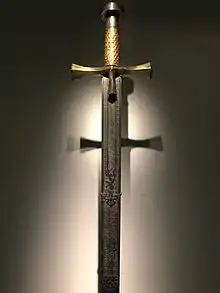| Ali Dinar | |
|---|---|
 Ali Dinar after his death in battle in 1916 | |
| Sultan of Darfur | |
| Reign | 1898–1916 |
| Predecessor | Position re-established |
| Successor | Position abolished |
| Born | 1856 |
| Died | 6 November 1916 (aged 59–60) Jebel Juba, Darfur |
| Dynasty | Keira dynasty |
| Father | Zakaria bin Sultan Mohammed Al Fadl |
Ali Dinar (Arabic: علي دينار, romanized: ʿAlī Dīnār; c. 1856 – 6 November 1916) was the last sultan of Darfur and ruler from the Keira dynasty.
In 1898, with the decline of the Mahdists, he managed to regain Darfur's independence.

A sword owned by Ali Dinar, heir to the throne of the Sultanate of Darfur. He was killed in action during the Anglo-Egyptian Darfur Expedition in 1916, with the sword being on display at the British Museum.
A rebellion led by him in 1915—in the context of his giving his support to the Ottoman Empire during the First World War— led the British government to dispatch the Invasion of Darfur, in which he was killed in action, after which his Sultanate was incorporated into Anglo-Egyptian Sudan.
Further reading
References
- Entry in the Encyclopædia Britannica
- Jay Spaulding,Lidwien Kapteijns: An Islamic alliance: ʻAlī Dīnār and the Sānūsiyya, 1906-1916 at Google Books
Wikimedia Commons has media related to Ali Dinar.
This article is issued from Wikipedia. The text is licensed under Creative Commons - Attribution - Sharealike. Additional terms may apply for the media files.